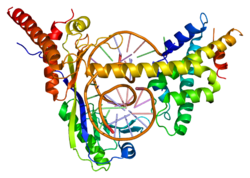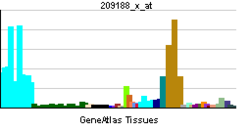- DR1 (gene)
-
Protein Dr1 is a protein that in humans is encoded by the DR1 gene.[1][2][3]
This gene encodes a TBP- (TATA box-binding protein) associated phosphoprotein that represses both basal and activated levels of transcription. The encoded protein is phosphorylated in vivo and this phosphorylation affects its interaction with TBP. This protein contains a histone fold motif at the amino terminus, a TBP-binding domain, and a glutamine- and alanine-rich region. The binding of DR1 repressor complexes to TBP-promoter complexes may establish a mechanism in which an altered DNA conformation, together with the formation of higher order complexes, inhibits the assembly of the preinitiation complex and controls the rate of RNA polymerase II transcription.[3]
Interactions
DR1 (gene) has been shown to interact with DRAP1.[4][5]
References
- ^ Inostroza JA, Mermelstein FH, Ha I, Lane WS, Reinberg D (Sep 1992). "Dr1, a TATA-binding protein-associated phosphoprotein and inhibitor of class II gene transcription". Cell 70 (3): 477–89. doi:10.1016/0092-8674(92)90172-9. PMID 1339312.
- ^ Purrello M, Di Pietro C, Rapisarda A, Viola A, Corsaro C, Motta S, Grzeschik KH, Sichel G (Mar 1997). "Genomic localization of the human gene encoding Dr1, a negative modulator of transcription of class II and class III genes". Cytogenet Cell Genet 75 (2–3): 186–9. doi:10.1159/000134479. PMID 9040789.
- ^ a b "Entrez Gene: DR1 down-regulator of transcription 1, TBP-binding (negative cofactor 2)". http://www.ncbi.nlm.nih.gov/sites/entrez?Db=gene&Cmd=ShowDetailView&TermToSearch=1810.
- ^ Yeung, K; Kim S, Reinberg D (Jan. 1997). "Functional dissection of a human Dr1-DRAP1 repressor complex". Mol. Cell. Biol. (UNITED STATES) 17 (1): 36–45. ISSN 0270-7306. PMC 231727. PMID 8972183. http://www.pubmedcentral.nih.gov/articlerender.fcgi?tool=pmcentrez&artid=231727.
- ^ Mermelstein, F; Yeung K, Cao J, Inostroza J A, Erdjument-Bromage H, Eagelson K, Landsman D, Levitt P, Tempst P, Reinberg D (Apr. 1996). "Requirement of a corepressor for Dr1-mediated repression of transcription". Genes Dev. (UNITED STATES) 10 (8): 1033–48. doi:10.1101/gad.10.8.1033. ISSN 0890-9369. PMID 8608938.
Further reading
- Maruyama K, Sugano S (1994). "Oligo-capping: a simple method to replace the cap structure of eukaryotic mRNAs with oligoribonucleotides". Gene 138 (1–2): 171–4. doi:10.1016/0378-1119(94)90802-8. PMID 8125298.
- Mermelstein F, Yeung K, Cao J, et al. (1996). "Requirement of a corepressor for Dr1-mediated repression of transcription". Genes Dev. 10 (8): 1033–48. doi:10.1101/gad.10.8.1033. PMID 8608938.
- Goppelt A, Stelzer G, Lottspeich F, Meisterernst M (1996). "A mechanism for repression of class II gene transcription through specific binding of NC2 to TBP-promoter complexes via heterodimeric histone fold domains". EMBO J. 15 (12): 3105–16. PMC 450253. PMID 8670811. http://www.pubmedcentral.nih.gov/articlerender.fcgi?tool=pmcentrez&artid=450253.
- Kashanchi F, Khleif SN, Duvall JF, et al. (1996). "Interaction of human immunodeficiency virus type 1 Tat with a unique site of TFIID inhibits negative cofactor Dr1 and stabilizes the TFIID-TFIIA complex". J. Virol. 70 (8): 5503–10. PMC 190508. PMID 8764062. http://www.pubmedcentral.nih.gov/articlerender.fcgi?tool=pmcentrez&artid=190508.
- Cowell IG, Hurst HC (1996). "Protein-protein interaction between the transcriptional repressor E4BP4 and the TBP-binding protein Dr1". Nucleic Acids Res. 24 (18): 3607–13. doi:10.1093/nar/24.18.3607. PMC 146135. PMID 8836190. http://www.pubmedcentral.nih.gov/articlerender.fcgi?tool=pmcentrez&artid=146135.
- Rozet JM, Gerber S, Perrault I, et al. (1997). "Structure and physical mapping of DR1, a TATA-binding protein-associated phosphoprotein gene, to chromosome 1p22.1 and its exclusion in Stargardt disease (STGD)". Genomics 36 (3): 554–6. doi:10.1006/geno.1996.0508. PMID 8884286.
- Yeung K, Kim S, Reinberg D (1997). "Functional dissection of a human Dr1-DRAP1 repressor complex". Mol. Cell. Biol. 17 (1): 36–45. PMC 231727. PMID 8972183. http://www.pubmedcentral.nih.gov/articlerender.fcgi?tool=pmcentrez&artid=231727.
- Suzuki Y, Yoshitomo-Nakagawa K, Maruyama K, et al. (1997). "Construction and characterization of a full length-enriched and a 5'-end-enriched cDNA library". Gene 200 (1–2): 149–56. doi:10.1016/S0378-1119(97)00411-3. PMID 9373149.
- Kamada K, Shu F, Chen H, et al. (2001). "Crystal structure of negative cofactor 2 recognizing the TBP-DNA transcription complex". Cell 106 (1): 71–81. doi:10.1016/S0092-8674(01)00417-2. PMID 11461703.
- Strausberg RL, Feingold EA, Grouse LH, et al. (2003). "Generation and initial analysis of more than 15,000 full-length human and mouse cDNA sequences". Proc. Natl. Acad. Sci. U.S.A. 99 (26): 16899–903. doi:10.1073/pnas.242603899. PMC 139241. PMID 12477932. http://www.pubmedcentral.nih.gov/articlerender.fcgi?tool=pmcentrez&artid=139241.
- Ota T, Suzuki Y, Nishikawa T, et al. (2004). "Complete sequencing and characterization of 21,243 full-length human cDNAs". Nat. Genet. 36 (1): 40–5. doi:10.1038/ng1285. PMID 14702039.
- Gerhard DS, Wagner L, Feingold EA, et al. (2004). "The Status, Quality, and Expansion of the NIH Full-Length cDNA Project: The Mammalian Gene Collection (MGC)". Genome Res. 14 (10B): 2121–7. doi:10.1101/gr.2596504. PMC 528928. PMID 15489334. http://www.pubmedcentral.nih.gov/articlerender.fcgi?tool=pmcentrez&artid=528928.
- Gilfillan S, Stelzer G, Piaia E, et al. (2005). "Efficient binding of NC2.TATA-binding protein to DNA in the absence of TATA". J. Biol. Chem. 280 (7): 6222–30. doi:10.1074/jbc.M406343200. PMID 15574413.
- Lewis BA, Sims RJ, Lane WS, Reinberg D (2005). "Functional characterization of core promoter elements: DPE-specific transcription requires the protein kinase CK2 and the PC4 coactivator". Mol. Cell 18 (4): 471–81. doi:10.1016/j.molcel.2005.04.005. PMID 15893730.
- Rual JF, Venkatesan K, Hao T, et al. (2005). "Towards a proteome-scale map of the human protein-protein interaction network". Nature 437 (7062): 1173–8. doi:10.1038/nature04209. PMID 16189514.
- Gregory SG, Barlow KF, McLay KE, et al. (2006). "The DNA sequence and biological annotation of human chromosome 1". Nature 441 (7091): 315–21. doi:10.1038/nature04727. PMID 16710414.
- Malecová B, Gross P, Boyer-Guittaut M, et al. (2007). "The initiator core promoter element antagonizes repression of TATA-directed transcription by negative cofactor NC2". J. Biol. Chem. 282 (34): 24767–76. doi:10.1074/jbc.M702776200. PMID 17584739.
PDB gallery Categories:- Human proteins
- Chromosome 1 gene stubs
Wikimedia Foundation. 2010.





